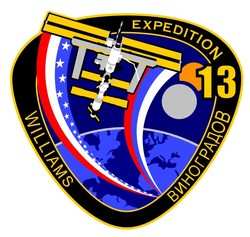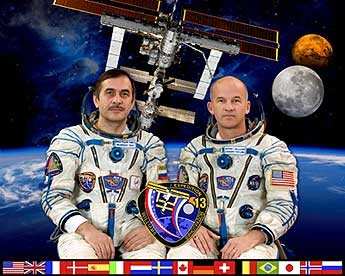ISS Report #25, 3:30 p.m. CDT, Friday, May 19, 2006
 In space this week, a satellite flew
within a satellite. International Space Station Flight Engineer
Jeff Williams 'piloted' a unique spacecraft in three dimensions for
the first time around the pressurized Destiny module. The
demonstration tested the basics of formation flight and autonomous
docking that could be useful in multiple spacecraft formation
flying in the future.
In space this week, a satellite flew
within a satellite. International Space Station Flight Engineer
Jeff Williams 'piloted' a unique spacecraft in three dimensions for
the first time around the pressurized Destiny module. The
demonstration tested the basics of formation flight and autonomous
docking that could be useful in multiple spacecraft formation
flying in the future.
That test flight culminated a week of experiment activity,
maintenance, spacewalk preparations and packing of equipment slated
for return to Earth aboard Space Shuttle Discovery following its
next mission to the station. The shuttle's launch is targeted for
July.
Along with Expedition 13 Commander Pavel Vinogradov, Williams
oversaw activities through the 50th day of their planned 180-day
voyage aboard the station focusing on laboratory science
experiments in the microgravity science glovebox. That facility
hosted the final sample for the Pore Formation and Mobility
Investigation experiment. This experiment uses a transparent
modeling material to study how bubbles form and migrate during
liquid solidification. This is important to understanding the
formation of flaws in molten metals as they solidify.
Much of the attention, however, focused on a new experiment
flying for the first time on the station called Synchronized
Position Hold, Engage, Re-orient Experimental Satellites, also
known as SPHERES.
Williams, also NASA's station science officer, performed a
series of test flights with the first of what eventually will be a
constellation of three small free-flying satellites designed to
demonstrate the basics of formation flight and autonomous
docking.
For the first tests, only one satellite and two beacons - one
mounted and one hand-held - were used. The satellite is eight
inches in diameter and has a mass of about seven pounds. It also
contains internal avionics, software and communications systems and
is maneuvered using compressed carbon dioxide gas thrusters.

Performed autonomously in Destiny, the first test flight
consisted of a series of 10-15 pre-planned maneuvers each lasting
up to 10 minutes. After Williams selected and loaded the
appropriate software on the laptop, the satellite began its
pre-programmed maneuvers to test attitude control, station keeping,
re-targeting, collision avoidance and fuel balancing.
This technology is of interest in designing constellation and
array spacecraft configurations and also could be used for
free-flying robotic assistants, capable of helping astronauts on
future spacewalks.
NASA's payload operations team at the agency's Marshall Space
Flight Center, Huntsville, Ala., coordinates U.S. science
activities on the station.
On the maintenance front, Vinogradov this week reconfigured
ventilation lines associated with the Elektron oxygen generating
system in the Zvezda module in preparation for a June 1 spacewalk.
One of the spacewalk tasks will be to install a new external
hydrogen vent line for the Elektron. Oxygen is being provided via
storage tanks in the Progress supply vehicle. The Elektron will
remain deactivated until after the spacewalk.
Early in the week, the carbon dioxide removal system, known as
Vozdukh, in the Russian segment malfunctioned. Flight controllers
activated the carbon dioxide removal system in Destiny until
troubleshooting restored Vozdukh's operation. Both units will run
in tandem until next week when a new gas analyzer is installed in
Vozdukh.
On Thursday, the crew talked with school students in Wisconsin's
Winter School District about life in space and experiments aboard
the station.
 SpaceX to Launch Inversion RAY Reentry Vehicle in Fall
SpaceX to Launch Inversion RAY Reentry Vehicle in Fall Aero-News: Quote of the Day (04.23.24)
Aero-News: Quote of the Day (04.23.24) Aero-News: Quote of the Day (04.20.24)
Aero-News: Quote of the Day (04.20.24) ANN's Daily Aero-Linx (04.20.24)
ANN's Daily Aero-Linx (04.20.24) Aero-News: Quote of the Day (04.21.24)
Aero-News: Quote of the Day (04.21.24)




